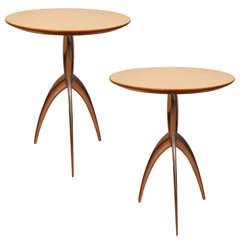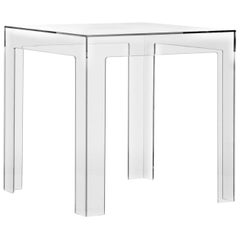Jolly Side Table
Recent Sales
20th Century American Mid-Century Modern Side Tables
21st Century and Contemporary Italian Modern Side Tables
Plastic
21st Century and Contemporary Italian Modern Side Tables
Lucite
Finding the Right Tables for You
The right vintage, new or antique tables can help make any space in your home stand out.
Over the years, the variety of tables available to us, as well as our specific needs for said tables, has broadened. Today, with all manner of these must-have furnishings differing in shape, material and style, any dining room table can shine just as brightly as the guests who gather around it.
Remember, when shopping for a dining table, it must fit your dining area, and you need to account for space around the table too — think outside the box, as an oval dining table may work for tighter spaces. Alternatively, if you’ve got the room, a Regency-style dining table can elevate any formal occasion at mealtime.
Innovative furniture makers and designers have also redefined what a table can be. Whether it’s an unconventional Ping-Pong table, a brass side table to display your treasured collectibles or a Louis Vuitton steamer trunk to add an air of nostalgia to your loft, your table can say a lot about you.
The visionary work of French designer Xavier Lavergne, for example, includes tables that draw on the forms of celestial bodies as often as they do aquatic creatures or fossils. Elsewhere, Italian architect Gae Aulenti, who looked to Roman architecture in crafting her stately Jumbo coffee table, created clever glass-topped mobile coffee tables that move on bicycle tires or sculpted wood wheels for Fontana Arte.
Coffee and cocktail tables can serve as a room’s centerpiece with attention-grabbing details and colors. Glass varieties will keep your hardwood flooring and dazzling area rugs on display, while a marble or stone coffee table in a modern interior can showcase your prized art books and decorative objects. A unique vintage desk or writing table can bring sophistication and even a bit of spice to your work life.
No matter your desired form or function, a quality table for your living space is a sound investment. On 1stDibs, browse a collection of vintage, new and antique bedside tables, mid-century end tables and more .
- What are side tables used for?1 Answer1stDibs ExpertApril 5, 2022Side tables are used next to furniture like beds and couches to provide an accessible place for keeping essential items at hand. In the living room, side tables are often used to display flower arrangements, photos or books as well as to set down a drink. In the bedroom, a side table is typically populated with items like a lamp, bedtime reading material, and a charging device for a phone. Shop a collection of vintage and contemporary side tables from some of the world’s top sellers on 1stDibs.
- What are nesting side tables?1 Answer1stDibs ExpertApril 5, 2022A nesting table is a set of tables designed to be stored one inside or under the other, giving them a layered or stacked appearance. A side table is a table that’s placed beside a piece of furniture. A nesting side table would be a series of side tables in graduated heights that can be stacked or nested together. Shop a collection of nesting tables from some of the world’s top sellers on 1stDibs.
- 1stDibs ExpertSeptember 25, 2019
A side table should stand one to three inches below the arm of the sofa or chair it is placed next to.
- What are side tables called?1 Answer1stDibs ExpertNovember 13, 2024Side tables are often simply called side tables. If positioned on either end of a sofa or loveseat, you might refer to them as end tables. General terms for side tables and other tables commonly used in seating areas include occasional tables and accent tables. On 1stDibs, shop a wide range of side tables.
- 1stDibs ExpertMay 5, 2023There are two differences between end tables and side tables: function and size. Typically, end tables go beside a chair or at opposite ends of a sofa and have smaller tabletops, while side tables go toward the sides of seating areas or against walls and feature a larger surface area. However, many people use the words side and end tables interchangeably, so these differences may not always apply. On 1stDibs, shop a variety of end and side tables.
- 1stDibs ExpertOctober 7, 2024The difference between a side table and a coffee table is mainly in the size and shape. Coffee tables usually feature larger tops but shorter legs. People typically place them in front of a sofa or a loveseat to rest books, drinks, remote controls and other items. Side tables also store items, but they are usually positioned beside an accent chair or at the ends of a sofa or loveseat. Shop a diverse assortment of side tables and coffee tables on 1stDibs.
- 1stDibs ExpertMay 5, 2023To determine whether a side table is an antique, closely examine its details. Older pieces will typically have telltale features like wood pegs, hand-cut dovetails with some slight imperfections and mortise-and-tenon construction. Tables that are a consistent color throughout or have machine-cut moldings or carvings are unlikely to be antiques. A certified appraiser or knowledgeable antiques dealer can be a helpful resource when dating tables. Shop a collection of antique, vintage and modern side tables on 1stDibs.
- 1stDibs ExpertMarch 25, 2024No, a side table shouldn't always be lower than a sofa. To make it easy to access items on a table, a sofa's arms should generally be no more than 2 to 3 inches above or below the tabletop. This rule of thumb differs from the one for coffee tables, which should be as tall or 1 to 2 inches shorter than the seat height of the sofa to ensure a balanced look. Explore a large selection of side tables on 1stDibs.
- 1stDibs ExpertSeptember 23, 2024What tiny side tables are called varies. Some people may simply refer to them as side tables. Others describe them as end tables if they're placed on either end of a sofa or loveseat. When used elsewhere in a room, small side tables are often called accent tables. On 1stDibs, explore a large selection of antique, vintage and contemporary side tables.
- 1stDibs ExpertSeptember 28, 2021A tall side table may also be called a console table. While these furnishings are not as common in today’s interiors as their coffee-table and side-table counterparts, console tables are stylish home accents and have become more prevalent over the years. The popularity of wood console tables took shape during the 17th and 18th centuries in French and Italian culture, and were exclusively featured in the palatial homes of the upper class. Find console tables today on 1stDibs.
Read More
20 Inviting Dining Rooms Perfectly Arranged for Entertaining
Top interior designers show — and tell — us how to create delectable spaces for hosting dinner parties.
This Alain Delon–Designed Table Is Almost as Handsome as He Was
Fans of the French film star may be surprised to learn that he had a flair for furniture with sleek lines and disco-era flash.
Uchronia’s Plant Stand Gives Pots a Pretty Perch with All the Trimmings
Like other pieces in the firm’s Candy Box collection, the cheerful limited-edition design showcases French craft.
The Ultimate Guide to Types of Tables for the Home
Whether you’re just moving in or ready to give your home a makeover, our guide will give you pointers on tables that are fitting for every room, nook and hallway.
Is Lionel Jadot the Willy Wonka of Upcycled Belgian Design?
From his massive collaborative workshop in a former paper factory, the designer concocts funky furniture from disused materials, as well as luxe hotel interiors like the new Mix Brussels.
Inspired by the Cosmos, Sandra Nunnerley’s Nova Table Has a Futuristic Feel
The designer’s innovative use of an unexpected material gives this console a lift.
This 19th-Century Gilded Desk Displays a Fanciful Kingdom in Marquetry
The stately piece brings both gravitas and whimsy to any work space.
In Guadalajara, These Luscious Side Tables Are Chiseled from Volcanic Rock
Use them as tables or stools, indoors or out.

